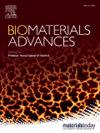Photoactive broad-spectrum dressings with antimicrobial and antitumoral properties
IF 5.5
2区 医学
Q2 MATERIALS SCIENCE, BIOMATERIALS
Materials Science & Engineering C-Materials for Biological Applications
Pub Date : 2024-12-20
DOI:10.1016/j.bioadv.2024.214158
引用次数: 0
Abstract
In this work the development of photoactive dressings (PAD) with dual purpose, is presented. These PAD can be used for the topical treatment of persistent infections caused by fungi and bacteria and are also applicable in light antitumor therapy for carcinoma.
The synthesized PAD were designed employing conjugated polymer nanoparticles (CPN) doped with platinum porphyrin which serve as polymerization photoinitiators and photosensitizers for the production of reactive oxygen species (ROS). This approach led to the synthesis of N-vinyl-2-pyrrolidone (NVP) hydrogels co-polymerized with [2-(methacryloyloxy)ethyl] trimethylammonium chloride (METAC). NVP and METAC were selected to impart a good biocompatibility with eukaryotic cell lines and antimicrobial properties, respectively. The combination of METAC with an efficient photogeneration of ROS by doped CPN resulted in a material with outstanding antimicrobial features. These dressings are capable of producing an aseptic environment upon irradiation and demonstrates a bacteriostatic profile in dark conditions. Additionally, the dressings fulfill critical requirements for topical applications, providing protection and acting as a barrier, with appropriate mechanical and swelling properties; as well as adequate water vapor transmission rates. The synthesized PAD have been shown to be biocompatible and non-toxic to erythrocytes and HaCaT cell line.
PAD demonstrated efficacy in eliminating microbes such as fungi and bacteria. The underlying light-induced killing mechanism involved protein photooxidation, which amplified the effects of METAC mechanism that disrupt cellular membranes. Furthermore, in vitro studies using carcinoma cell lines displayed a complete cell eradication using a relatively low light dose (36 J/cm2 at 395 nm). These promising results reveal also the potential of PAD in the treatment of skin cancer.
具有抗菌和抗肿瘤特性的光活性广谱敷料。
本文介绍了两用光活性敷料(PAD)的发展情况。这些PAD可用于真菌和细菌引起的持续性感染的局部治疗,也可用于癌症的轻度抗肿瘤治疗。采用掺杂铂卟啉的共轭聚合物纳米颗粒(CPN)作为聚合光引发剂和光敏剂制备活性氧(ROS)。该方法合成了n -乙烯基-2-吡咯烷酮(NVP)与[2-(甲基丙烯酰氧基)乙基]三甲基氯化铵(METAC)共聚合的水凝胶。选择NVP和METAC分别具有良好的真核细胞系生物相容性和抗菌性能。METAC与掺杂CPN的ROS的高效光生成相结合,产生了具有出色抗菌特性的材料。这些敷料能够在照射后产生无菌环境,并在黑暗条件下显示出抑菌性。此外,敷料满足局部应用的关键要求,提供保护和作为屏障,具有适当的机械和肿胀特性;以及足够的水蒸气透过率。合成的PAD对红细胞和HaCaT细胞系具有生物相容性和无毒性。PAD在消除真菌和细菌等微生物方面表现出功效。潜在的光诱导杀伤机制涉及蛋白质光氧化,这放大了破坏细胞膜的METAC机制的作用。此外,使用癌细胞系进行的体外研究显示,使用相对较低的光剂量(36j /cm2, 395 nm)可以完全根除癌细胞。这些有希望的结果也揭示了PAD治疗皮肤癌的潜力。
本文章由计算机程序翻译,如有差异,请以英文原文为准。
求助全文
约1分钟内获得全文
求助全文
来源期刊
CiteScore
17.80
自引率
0.00%
发文量
501
审稿时长
27 days
期刊介绍:
Biomaterials Advances, previously known as Materials Science and Engineering: C-Materials for Biological Applications (P-ISSN: 0928-4931, E-ISSN: 1873-0191). Includes topics at the interface of the biomedical sciences and materials engineering. These topics include:
• Bioinspired and biomimetic materials for medical applications
• Materials of biological origin for medical applications
• Materials for "active" medical applications
• Self-assembling and self-healing materials for medical applications
• "Smart" (i.e., stimulus-response) materials for medical applications
• Ceramic, metallic, polymeric, and composite materials for medical applications
• Materials for in vivo sensing
• Materials for in vivo imaging
• Materials for delivery of pharmacologic agents and vaccines
• Novel approaches for characterizing and modeling materials for medical applications
Manuscripts on biological topics without a materials science component, or manuscripts on materials science without biological applications, will not be considered for publication in Materials Science and Engineering C. New submissions are first assessed for language, scope and originality (plagiarism check) and can be desk rejected before review if they need English language improvements, are out of scope or present excessive duplication with published sources.
Biomaterials Advances sits within Elsevier''s biomaterials science portfolio alongside Biomaterials, Materials Today Bio and Biomaterials and Biosystems. As part of the broader Materials Today family, Biomaterials Advances offers authors rigorous peer review, rapid decisions, and high visibility. We look forward to receiving your submissions!

 求助内容:
求助内容: 应助结果提醒方式:
应助结果提醒方式:


